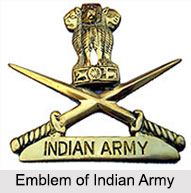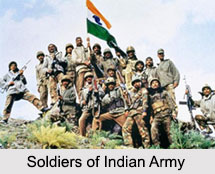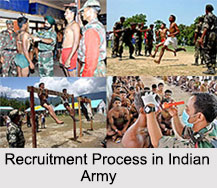 Indian Army is the largest branch of the Armed Forces of India and it has the primary responsibility of conducting land based military operations, in and around India. It is the second largest active military force in the world. It has 1,220,010 active personnel and 990,960 reserve personnel. Indian Army personnel offer voluntary service and a military draft has never been imposed in India. The army has rich battling experience, as it has fought in diverse geographical areas and conditions. The force is currently being headed by the Chief of Army Staff (COAS). The highest rank in the Indian Army is that of a Field Marshal, but it is an honorary rank and appointments are made by the President of India on the advice of the Union Cabinet of Ministers, only in exceptional circumstances. Indian Army functions to maintain peace and security within the borders of the nation.
Indian Army is the largest branch of the Armed Forces of India and it has the primary responsibility of conducting land based military operations, in and around India. It is the second largest active military force in the world. It has 1,220,010 active personnel and 990,960 reserve personnel. Indian Army personnel offer voluntary service and a military draft has never been imposed in India. The army has rich battling experience, as it has fought in diverse geographical areas and conditions. The force is currently being headed by the Chief of Army Staff (COAS). The highest rank in the Indian Army is that of a Field Marshal, but it is an honorary rank and appointments are made by the President of India on the advice of the Union Cabinet of Ministers, only in exceptional circumstances. Indian Army functions to maintain peace and security within the borders of the nation.
History of Indian Army
The Indian Army was founded on 1st of April, 1895. It underwent many changes in its formation, structure, war policy, etc. from the ancient period to medieval period to the modern period. The Indian Army in different periods is classified below:
Indian Army during Ancient Period
The organization of Indian Army during ancient period used to change, depending upon the ruling empire. In ancient times, "dharma" was a significant part of everyday life, so warfare took place frequently. Ancient texts and scriptures like Vedas and epics like Mahabharata and Ramayana provide earliest records related to the Indian Army. 
Indian Army during Medieval Period
Indian Army during medieval period was not quite united. It was rather undisciplined. In the medieval period, Indian emperors applied a number of tactics and diplomatic policies for winning a war and also sometimes for avoiding an open war. The Afghan rulers had ruled India for a considerable number of years during the medieval period and they had made some remarkable contributions to the formation and structure of the Indian Army. The Afghan rulers had ruled Delhi and its surrounding area for years before the Mughal emperor, Babur took control of the region. The great Afghan ruler, Sher Shah had also ruled India after the death of Babur and the defeat of Babur`s son, Humayun. Indian Army during Afghan rule was vast and well organized and had separate divisions.
Indian Army during Mughal Period
The indiscipline and divided structure of the Indian Army in the ancient times improved during Mughal rule. The size of the Indian Army was quite large during Mughal rule. The Mughal rulers showed considerable amount of interest in organizing the Indian Army in a proper way. They had done a good job in changing the formation, structure and strength of the Indian Army. Though there was improvement in the unity of the army, Indian Army during Mughal Period was not controlled properly. The situation improved during the Maratha period.
Indian Army during British Rule
Indian Army during British rule became disciplined. It is a well known fact that the East India Company (EIC) was the company through which the British rulers came to India and ruled the country for near about 200 years in succession. The East India Company had played the most significant role in modernizing the Indian Army to a great extent, during its reign in India. Apart from modernization, the British rulers introduced professional security in the Indian Army. 
Indian Army after Independence
Indian Army after Independence underwent a lot of changes and had significantly increased its strength. Indian independence in 1947 brought about a huge change in the formation, structure and size of the Indian Army. After independence, the Indian Army was not required to serve a foreign government. It represented the Indian society as a whole, unlike most of the imperial armies. The army had the most developed and modern weapons to fight against its enemies.
Military Organization of Indian Army
Military Organisation of Indian Army in the 17th century relates to changes in the unit, as European military methods were followed. Presently, the troops of the Indian Army are ordered into 40 Divisions in 14 Corps. It has 6 operational commands and one training command. Each command is lead by General Officer Commanding-in-Chief, with the rank of Lieutenant General. Apart from field corps, the Indian Army has corps like the Armored Corps, Regiment of Artillery, Corps of Army Air Defence, Army Aviation Corps and Corps of Engineers.
Military Operations of Indian Army
Military Operations of Indian Army has demonstrated the strength of the unit. Since independence, the Indian Army has carried over a large number of military operations in order to safeguard the country"s territory and also to restrain the enemies from causing any damage to India. Almost all the military operations of Indian Army have so far resulted in considerable success. Some of the military operations of Indian Army are Indo-Pakistani Wars and Kashmir Conflict, Kargil War, Annexation of Goa and Sino-Indian War. The Indian Army also has a distinguished history of serving in the United Nations peacekeeping operations.






